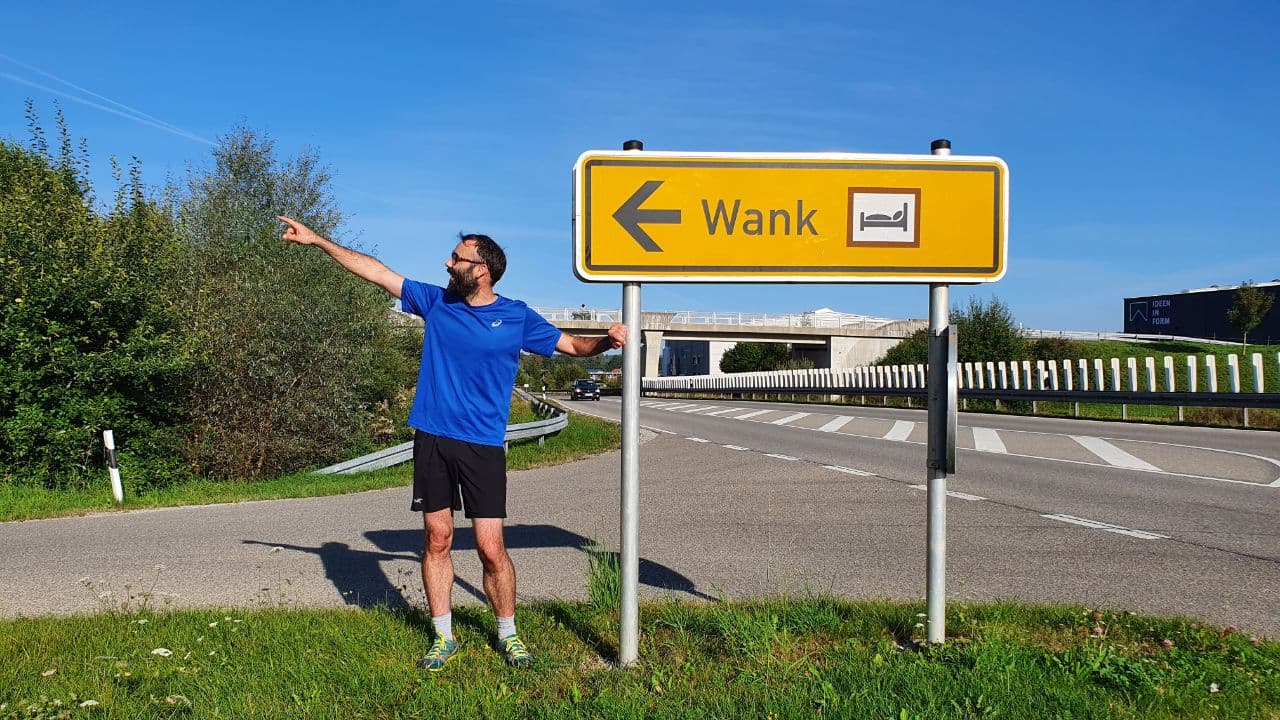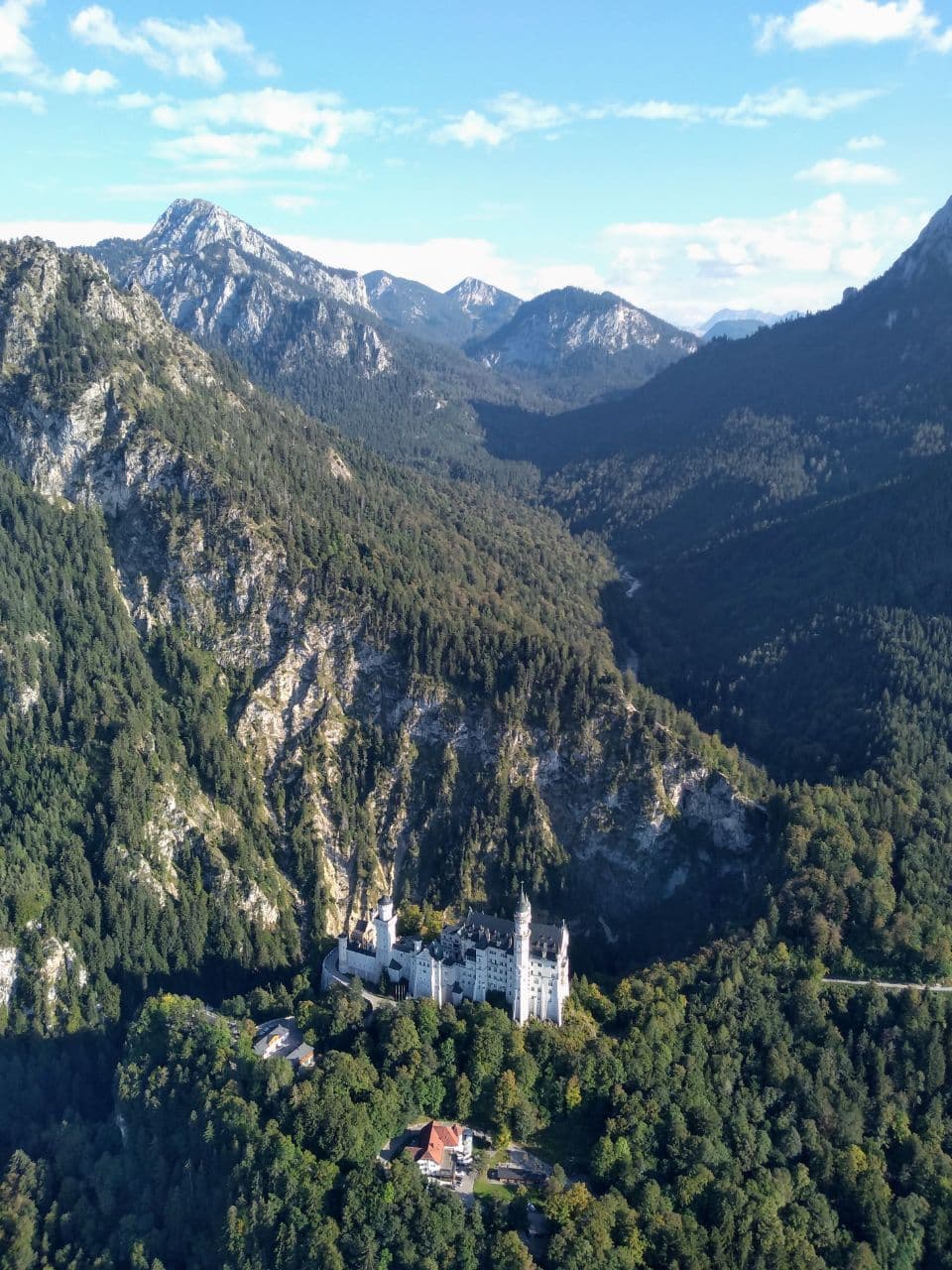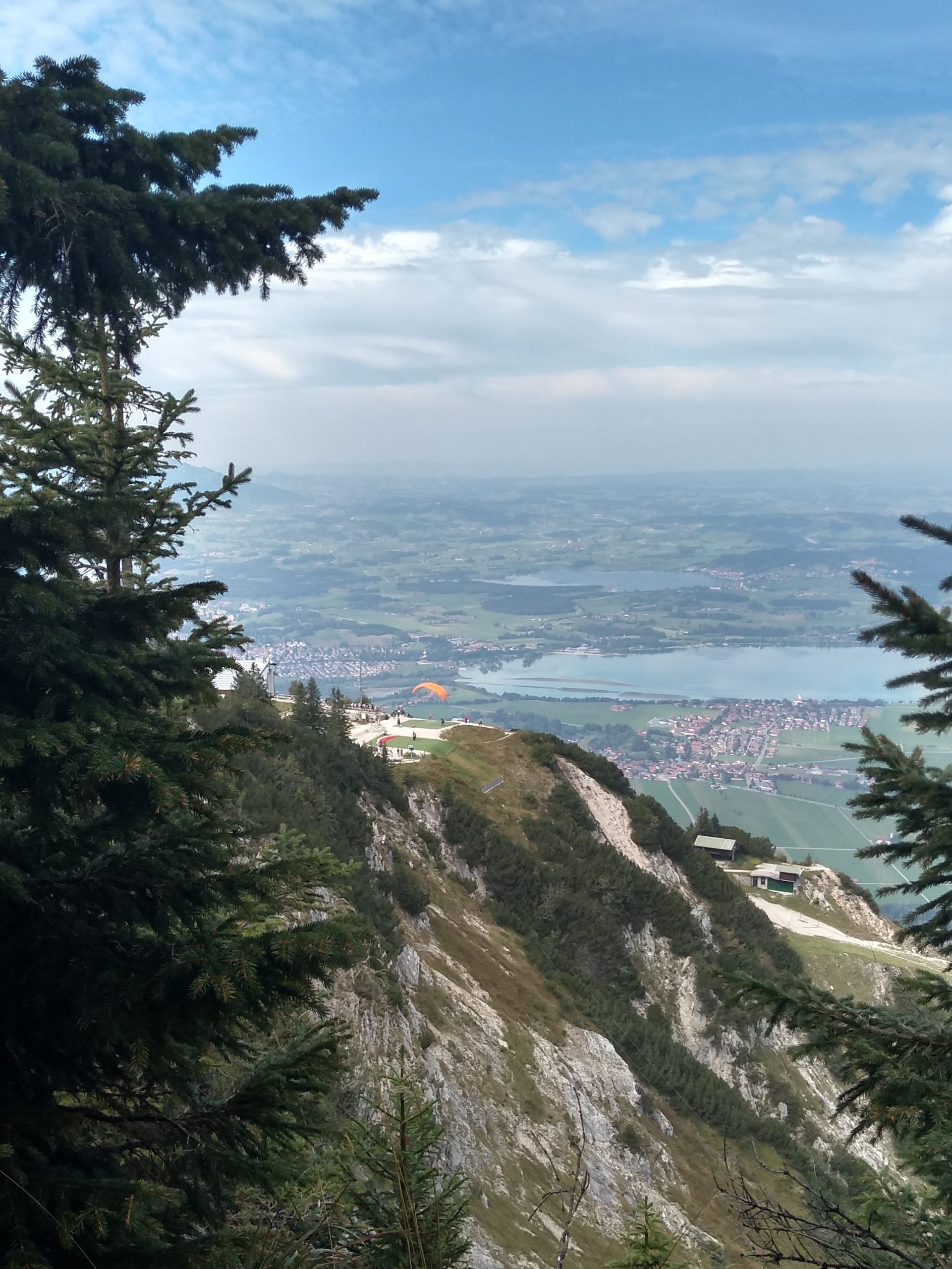A lesson in Assertiveness at Tegelberg
In September 2020, as Covid was beginning to get worse in both the UK and Europe, Albatross Paragliding headed to the German Alps for a final bout of summer freedom.
Usually we choose our destination according to the weather. In this, strangest of years, we chose according to the quarantine restrictions and the rate of Covid infections. Germany was doing way better than the UK at the time, and was just about the only nearby country with mountains where we would not have to quarantine on our return.
We stayed the town of Nesselwang, just next to the village of, ahem, Wank, South of Munich. The landscape was green, rolling and pastoral, with a sudden and dramatic transition from the plain to the mountains. I had not realised how serious the German alps are – there are many peaks going up to 2000m, and some nearly 3000m, encompassing spectacular forests and rocky ridges, whilst the plain has countless glistening lakes with gorgeous swimming spots.

For the first few days we explored the sites closest to us: Alpspitz, beautiful but not really enough sunny, steep and rocky faces to overcome the stable airmass; and then Breitenberg, where the Finkelstein ridge in front served up some monstrous lee side climbs. It’s nice to have an option in-between a giant spin dryer and a top-to-bottom. Tegelberg promised exactly that.
Tegelberg is a popular tourist spot – with a fairy tale castle that featured in Chitty Chitty Bang Bang. The local pilots warned us that the queue for the cable car in mid-afternoon can be up to an hour – and this was in a weekday in September. So we were eager to avoid bombing out – best not to launch until the thermals got going. Our expectation built as the cable car whisked us up the mountain – the scenery was exquisite: soaring towers of granite arranged in semi-circle, overlooking dense steeply sloped forest with a huge lake on our right, and the turrets of the Disney castle on our left. The rock face beneath us became almost vertical for the last part of the cable car ride. Climbers were scaling the cliff faces, while equally courageous walkers were taking on an insane zig-zagging path up a ravine.

On arrival we located the launches and settled down to observe, eat lunch, and wait for the thermals to begin. There are two launches, North West and North East, both on the same exposed spur, from which a thermal can puff up on either side. The surface is carpeted, flat on top, abruptly becoming steeply sloping, a bit gravelly lower down, then a few metres of scrub, before becoming near vertical. There’s enough room on each launch for one glider at a time. To the left of the NW launch, a 4ft high raised metal ramp accommodates hang-gliders, and provides an extra obstacle to avoid for PGers. All easy enough if your launch skills are good, but the stakes are high if you get it wrong.
We were a little bit surprised to see a school lobbing off students on the NW launch. They were queuing just in front of the tourist viewing gallery. An instructor in a red T-shirt barked orders, his minions laid out each student’s wing, a few checks, and off they went, often with the instructor grabbing a line or two to correct the control inputs.
As the thermals started to pick up, things got more interesting. The students started to struggle a bit more. The wing minions were still laying out right on top of the launch, which was sheltered from the breeze by the abrupt change from steep slope to flat top. And the breeze was now about 8-10mph NNW to N, but the minions insisted on laying out in perfect alignment with the carpet, facing NW, rather than into wind. And nobody seemed to have heard of reverse launching. The results were predictable: carnage. Surging inflations, collapses on the right wingtip, draggings towards the HG ramp, and a stressed instructor who kept shouting “Bremsen, Laufen, NEIN NEIN!” as his students failed to live up to his expectations.
Then it got even more interesting. As I talked to local pilots I found out that they weren’t just his students – he was “helping” everyone! He was the launch marshal as well as instructor. Everyone was meant to queue, have their wing laid out by the hapless minions, and be shouted at for getting it wrong; all watched by the crowd of tourists baying for blood. It turns out that German alpine pilots aren’t used to a 10mph breeze, and the experienced pilots weren’t much better at launching than the students.
I was reminded of a General Aviation accident report I read recently – a young pilot, with an attitude that was perhaps too eager to please, being mucked about by Air Traffic Control on approach to major airport while flying a light aircraft. ATC kept trying to bring her in with faster aircraft too close behind, forcing her to abort at the last minute and loop around for another go. After a couple of attempts at following their dodgy instructions, she got flustered, forgot to increase airspeed before dis-engaging the flaps, stalled, spun in and crashed. In other words, the wrong sort of social pressure can be deadly.
One of the things I love most about paragliding is that it makes demands on every part of us: not just fitness and coordination, but also understanding of the environment and oneself. A good pilot needs humility to listen to advice, balanced by courage to make their own decisions.
I was proud of how our group did that day. RJ Macaulay fought off the minions, contradicted the instructor, and insisted on laying his wing out at the front of the slope, into wind, and reverse launched first time. All of our group launched safely. Respect especially to Martin Ayers, who, having slightly sprained his ankle earlier in the week, found it more challenging. After a failed attempt, the ever-helpful instructor relegated him to wait on the side, along with another German pilot. “So vee are in ze loosers’ corner yah!” he joked. They both launched successfully after finally being allowed another go.
As for me, I knew that this sort of pressure was not going to be helpful for my personality. Next to me in the queue was a friendly acro pilot. I asked him “Given the breeze is NNW, how about the North East launch?” – “possible, but a bit more difficult”, this confirmed my own assessment, and I needed no more encouragement.
Nobody else was trying to takeoff from the NE launch, so I had plenty of time to prepare and wait for a little puff of wind coming up the face. A committed run, and I was off first time, and away from the crowds, into a steep bowl crowned by majestic towers of rock. I climbed effortlessly into the delicious, burning blue. I flew straight to the far end of the ridge, to the flying site of Buching (Oliver Guenay’s Best Flying Sites of the Alps recommends Buching and back as a nice easy task).

My return was not so easy, a light headwind, and the gentler terrain at that end of the ridge conspired to leave me stranded on a wooded peak. The locals had previously recommended this peak (the Rohrkopf) as a reliable thermal generator. It was reliably weak. I spent what seemed like an eternity (probably 15 minutes) eking out every last bit of lift, rarely getting more than 300 ft above the top.
Then Martin appeared a few hundred feet above me, and showed me the way to the next climb – a steep ski piste further along the ridge. I squeezed as close as I dared between two rocky outcrops on the way, and sure enough found very gentle but consistent lift. I worked my way up above a mountain restaurant and then back onto some sunny rock faces where the climb both strengthened and smoothed out. I went from soaring beats to 360s, and the view once again opened up. The crowds were still hovering around the launch further south, so I was free to settle into my harness, totally relaxed. As the view got more and more epic, I reflected on how lucky I was to be there – in the middle of a world-wide pandemic, so much suffering and chaos, but the mountains still so beautiful. I felt small and insignificant above the enormous jagged peaks. There was a burning in my chest as my eyes began to well up. “Hey, none of that!” I said to myself – teary eyes are no good for collision avoidance. Nonetheless, it was a spiritual moment – I felt blessed to be alive.
Dave Harvey is CFI at Albatross Paragliding and Chief Coach at the Sky Surfers Club
ADVICE FOR FLYING IN THE BAVARIAN ALPS
GET YOUR PAPERS IN ORDER
- Pilot rating: if you want to fly without supervision from a German instructor, you need an IPPI level 5 card, which is equivalent to Pilot rating. You can obtain your IPPI card from the BHPA.
- Authorisation card: Many sites, including Tegelberg and Breitenberg, require you to obtain a special coloured authorisation card before you fly. This is given by the local schools and/or lift ticket office after checking your qualifications (IPPI level 5) and insurance.
- Proof of insurance: can be in the form of the BHPA “Evidence of insurance” document, along with your BHPA membership card.
- Sign the register: Most mountain sites have a pilot’s register which you must sign at the bottom lift station, where you write your name, contact details, and authorisation card number.
GOING UP THE MOUNTAIN
- Lift tickets can be pricey –12 to 17 euros per trip up the mountain. It can work out cheaper to get a ticket with “points”, which can then be used at several sites (Breitenberg and Tegelberg) and even shared between people in the case of the 200 point card.
- Your accommodation may come with a “Konigskarte”, which may give you discounted lift tickets.
- Always ask at the lift ticket office if there is a discount for “Gleitschirm Piloten” (Paraglider pilots).
WHERE TO GET HELP
- We found the local instructors super friendly and helpful (the one on Tegelberg launch was an exception). Be sure to make contact and try to get advice from locals rather than fellow tourists.
- Oliver Guenay’s book Best Flying Sites of the Alps contains many listings for German mountain sites.
